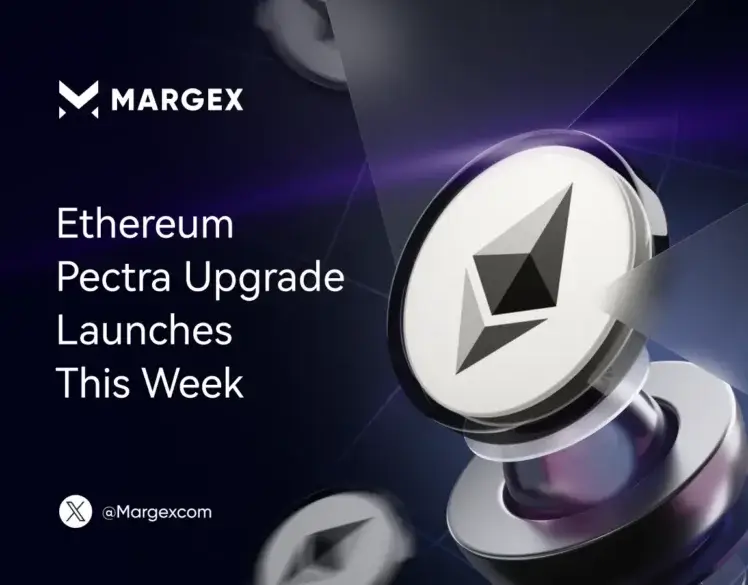Ethereum Hard Fork Pectra Coming This Week. Here’s What It's About

The Ethereum Pectra upgrade (hardfork) scheduled to be activated on May 7, 2025, is expected to have a significant beneficial impact on the second-largest blockchain, namely expand its scalability, improve user experience and validator operations. This upgrade will be a combination of the Prague and Electra proposals and is expected not only to boost its technical features but is also likely to drive its performance up.
This week, the first part of the hard fork will take place. The second one will be implemented next year. The Pectra upgrade comes after several hard forks that have been implemented since 2022 – The Merge (2022), Shanghai (2023) and Dencun (2024). They have been gradually moving Ethereum into the Ethereum 2.0 phase, also helping it switch from Proof-of-Work to the Proof-of-Stake algorithm.
Major technical improvements Pectra to bring on Ethereum
This hardfork includes several major Ethereum Improvement Proposals (EIPs for short). Each of them was designed by developers to improve various aspects of the Ethereum network. These positive changes will contribute to a scalability increase, improvements in user experience, and a stronger validator infrastructure. All these could have long-term effects on Ethereum’s viability in the years to come.
Account abstraction (EIP-7702). Account abstraction is one of the changes in Pectra that have been expected by the community for a long time to happen. It will allow externally owned accounts (EOA) will get smart contract functionality. One of the most important outcomes of this upgrade is that users will be able to pay gas fees not only with ETH but with stablecoins, such as USDC and DAI. Transaction batching will also take place, allowing for multiple transactions to be tied into a single one to bring down costs. This will make Ethereum more flexible and will increase its usability. Particularly for decentralized applications (dapps), blockchain-powered games, and mobile applications. In short, it will enable users and developers to interact with the network more efficiently.
Validator enhancements (EIP-7251, 7002, 6110, 7685). This upgrade will bring important adjustments to Ethereum’s staking system. EIP-7251 will allow validators to stake from 32 ETH to 2,048 ETH, expanding the staking maximum limit. This is supposed to bring more institutional validators to Ethereum and enhance the network security. EIP-7002 will introduce flexible withdrawals of staked ETH coins, allowing users to exit staking without long delays. The process of validator onboarding and exiting will also be improved and simplified. This will help both individual and institutional validators to manage their staking activity and operations more easily. Overall, this should make Ethereum’s Proof-of-Stake-based network more efficient and scalable, helping it leave the outdated and energy-wasteful Proof-of-Work consensus in the past.
| Day | Minimum Price | Average Price | Maximum Price |
|---|
Layer-2 scaling improvements (EIP-7691). Another notable improvement to be brought to Ethereum through Pectra is an increase in the number of so-called “blobs”. These are data units that fit into each block. Their number will increase from three to six and potentially even up to nine. This change will significantly improve the work of layer-2 solutions on Ethereum (such as Arbitrum or Optimism) and enhance their scalability, reducing congestion. These solutions were already designed to take a lot of transaction load off Ethereum, but they still face difficulties in doing so.
This will make it easier for decentralized applications (DeFi), non-fungible tokens (NFTs), and games powered by blockchain to scale. In general, it aims to increase Ethereum’s overall throughput to allow it to handle a bigger volume of transactions.
Potential ETH price boost
Many analysts believe and many Ethereum holders hope that a successful implementation of the Pectra hard fork will have a definite positive impact on the Ethereum price in the future. With the significant increase of ETH that can be staked (from 32 to 2,048 ETH), the amount of coins that will thus be locked out of circulation will definitely increase, greatly reducing the ETH supply in circulation. This could add upward pressure on the ETH price.
Besides, the usability of the Ethereum network surges indeed, it will attract many new users and developers, a lot more new dapps and games will be launched and NFTs minted, expanding its utility and adoption. This should increase Ethereum’s appeal to ETH investors.
This is likely to have a positive impact on the broad market sentiment and bolster confidence in Ethereum. Besides, spot ETFs continue to accumulate Ethereum after the launch in May 2024. If Pectra is integrated smoothly with all the positive aftermath for the network, it could also cause a great increase in ETH purchasing by the ETFs. Currently, Ethereum is trading at $1,815 after it managed to regain the $1,860 level on May 1.


